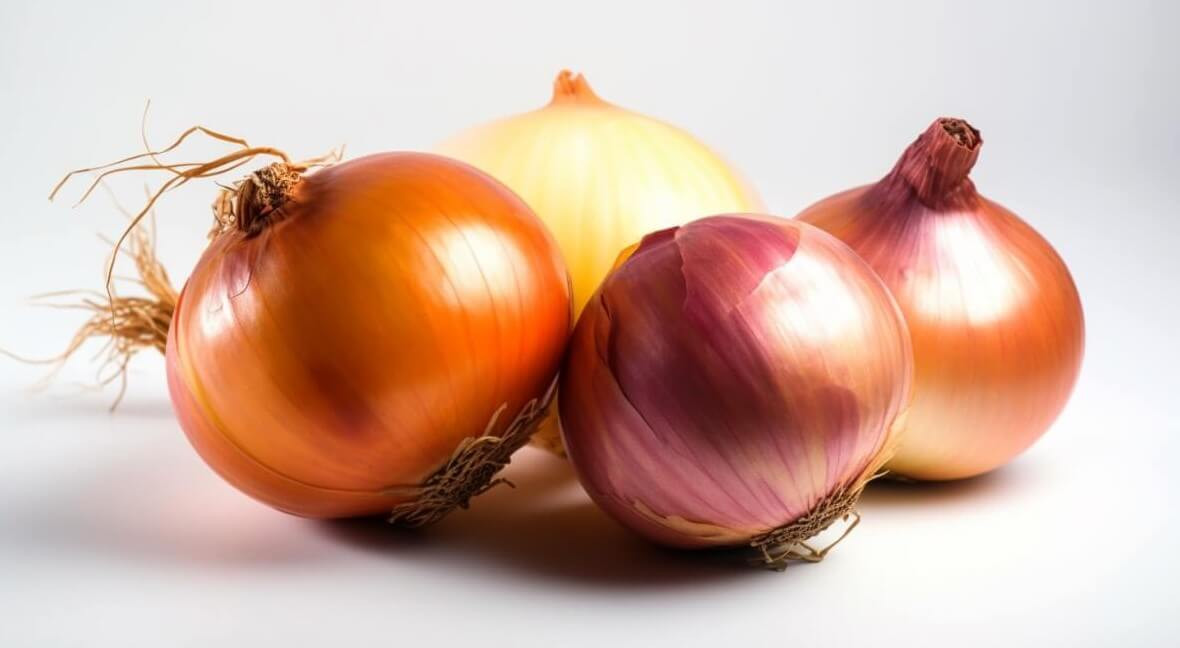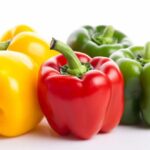Would you prefer to listen to a short podcast discussion about this article? Click on the audio below.
If you're looking to add a delicious and nutritious ingredient to your homegrown produce, growing onions is a great place to start. Not only are they easy to grow, but they can also be harvested year-round in the UK. In this article, we will cover all the basics of growing your own onions, from selecting the right varieties to troubleshooting common problems.
Table of Contents
Preparing the Soil for Growing Onions
Before planting your onions, it's important to make sure that your soil is suitable for their growth. Onions prefer well-draining soil with a pH of around 6.0-7.0. To achieve this, you'll need to prepare your soil properly. Start by removing any weeds and debris from the area where you plan to plant your onions.
Next, work in some organic matter, such as well-rotted manure or compost, into the soil to improve its structure and add nutrients. Make sure to break up any clumps and remove any large stones or debris. Finally, level the soil and create a shallow trench for planting the onions.
Choosing the Right Onion Varieties for UK Conditions
When it comes to selecting onion varieties for UK conditions, there are many options to choose from. However, it's important to choose a variety that suits your region and preferred growing conditions. For example, long-day onion varieties are generally better for northern regions with longer daylight hours, while short-day varieties are better for southern regions with shorter days.
Other factors to consider when selecting onion varieties include size, flavour, colour, and storage life. Some popular onion varieties for gardeners include Alisa Craig, Ailsa Craig, Red Baron, and Sturon.

Planting Onions at the Right Time
Onions are a versatile and flavorful vegetable that can be used in a variety of dishes. Whether you prefer them raw in salads or cooked in soups and stews, planting onions at the right time is essential for a successful harvest.
Spring plantings are a great option for those who want to get a head start on their onion crop. Starting seeds indoors in February or March allows you to get a jump on the growing season and ensures that your onions will be ready to harvest by late summer. When planting outdoors, it's important to wait until the soil has warmed up in late March or early April to prevent your onions from rotting in the ground.
On the other hand, fall plantings can be a good option for those who live in areas with mild winters. Planting in late September or early October allows your onions to establish roots before the ground freezes, giving them a head start on growth in the spring. Fall plantings also tend to produce larger bulbs than spring plantings.
When planting your onions, it's important to space them at least 4-6 inches apart to allow room for growth. Plant them 1 inch deep in the soil and cover them with soil, leaving only the top of the bulb exposed. Water thoroughly to ensure that the soil is moist and the onions have the nutrients they need to thrive.
Onions are a low-maintenance crop that requires minimal attention once they are planted. However, it's important to keep an eye on them and make sure they are getting enough water and nutrients throughout the growing season. With the right timing and care, you can enjoy a bountiful harvest of delicious onions that will add flavour and nutrition to your meals.
Watering and Fertilizing Onions
Onions are a versatile and delicious vegetable that can be used in a variety of dishes. They are a staple ingredient in many cuisines around the world, including Italian, Mexican, and Indian. Growing onions in your garden can be a rewarding experience, but it is important to know how to properly care for them.
Onions require consistent watering to keep the soil moist but not waterlogged. When planting onions, it is important to choose a location with well-draining soil. Onions do not like to sit in water, as this can lead to root rot and other fungal diseases. If you live in an area with heavy clay soil, consider amending the soil with organic matter such as compost or peat moss to improve drainage.
Water your onion plants regularly, about once or twice a week, depending on the weather and soil conditions. Onions need about 1 inch of water per week, either from rainfall or irrigation. If you are using a sprinkler system to water your garden, be sure to water early in the day so that the foliage has time to dry before nightfall. This can help prevent fungal diseases such as mildew and rot.
When watering your onions, it is important to water the soil, not the leaves. Wet foliage can attract pests and diseases, and can also lead to sunscald on hot, sunny days. Use a drip irrigation system or a watering can to water at the base of the plants.
In addition to consistent watering, onions also benefit from regular fertilization. You can fertilize your onions once a month with a balanced fertilizer, such as a 10-10-10 formula. This will provide them with the nutrients they need to grow strong and healthy. Alternatively, you can use organic matter such as compost tea to provide additional nutrition for your onions. Compost tea is made by soaking compost in water for several days, then straining out the solids and using the liquid to water your plants.
By providing your onions with consistent watering and fertilization, you can ensure a bountiful harvest of delicious, healthy onions. Onions are a popular and versatile vegetable that can be used in a wide variety of dishes. However, as with any plant, they are vulnerable to a range of pests and diseases that can cause significant damage and reduce your crop yield.
In this section, we'll take a closer look at some of the most common pests and diseases that affect onions and explore some strategies for controlling them. One of the most common pests that affect onions is the onion maggot. These small, white larvae feed on the roots and bulbs of onion plants, causing significant damage and reducing the size and quality of your crop.
To prevent onion maggots, it's important to keep your onion bed clean and free of debris, as these pests are attracted to decaying organic matter. You can also use natural methods like companion planting with plants like marigolds, which help repel onion maggots. Another common pest that affects onions is thrips. These tiny insects feed on the leaves of onion plants, causing them to turn yellow and wilt.
To prevent thrips, it's important to keep your onion bed well-watered and to avoid over-fertilizing your plants, as this can attract these pests. You can also use natural methods like spraying your plants with a mixture of water and dish soap, which can help suffocate thrips and prevent them from spreading. In addition to pests, onions are also vulnerable to a range of diseases, including white rot.
This fungal disease causes the roots and bulbs of onion plants to rot, resulting in significant damage and reduced crop yields. To prevent white rot, it's important to keep your onion bed well-drained and to avoid over-watering your plants. You can also use natural methods like spraying your plants with a mixture of water and baking soda, which can help prevent the spread of this disease.
If you do notice any pests or diseases on your onion plants, it's important to take action immediately. Remove infected plants and treat the area with a natural fungicide or insecticide, like neem oil or pyrethrin. By taking these steps and staying vigilant for signs of pests and diseases, you can help ensure a healthy and bountiful onion crop.
Harvesting and Storing Onions
Onions are a staple in many dishes, adding flavour and depth to soups, stews, and sauces. Growing onions is a satisfying and rewarding experience, but the real challenge comes in harvesting and storing them properly to ensure that you can enjoy them for months to come.
When it comes to harvesting onions, timing is everything. You want to wait until the onions have reached their full size and the tops have started to yellow and fall over. This indicates that the onion has stopped growing and is ready to be harvested. Be sure to use a garden fork to gently lift the bulbs out of the soil, being careful not to damage them in the process.
Once you have harvested your onions, it's time to dry them out. This is an important step in the process because it allows the onions to cure, which means that the outer layers will dry and harden, protecting the inner layers from rot and decay. The best way to dry onions is to spread them out in a warm, well-ventilated area for several weeks. You can leave them on a wire rack or spread them out on a clean, dry surface.
While your onions are drying, it's important to keep an eye on them and make sure that they are not exposed to any moisture or humidity. If you live in a particularly humid area, you may want to use a dehumidifier to keep the air dry. You can also use a fan to increase airflow and speed up the drying process.
Once your onions are completely dry, it's time to store them. The key to storing onions is to keep them in a cool, dry place with good airflow. You can braid the leaves together and hang them up, store them in mesh bags, or place them in a well-ventilated box. It's important to avoid storing onions in plastic bags or containers, as this can trap moisture and cause them to rot.
Properly stored onions can last for several months, so be sure to check on them periodically to make sure that they are still in good condition. If you notice any signs of decay or mould, remove the affected onions immediately to prevent the problem from spreading to the rest of your crop.
Tips for Growing Onions in Containers
If you're short on space, onions can also be grown in containers. When growing onions in containers, choose a pot that's at least 8 inches deep and has good drainage. Fill the container with well-draining soil and plant the onions as you would in the ground.
Make sure to water the containers more frequently, as the soil in containers can dry out more quickly. You can also add a slow-release fertilizer to the soil before planting to provide additional nutrients for your onion plants.

Companion Planting for Onions
Companion planting is the practice of planting certain crops together to improve their growth and health. For onions, some good companion plants include carrots, lettuce, and chamomile.
These plants can help repel pests and provide a natural source of nitrogen for your onions. They also have shallow roots that won't compete with your onion plants for nutrients or water.
Dealing with Onion Weeds
Weeds can be a common problem when growing onions, but there are ways to deal with them. One option is to manually remove weeds as they appear, being careful not to disturb the onion roots.
Alternatively, you can use organic weed control methods, such as mulching with straw or applying a homemade weed killer made from vinegar and dish soap.
Troubleshooting Common Onion Problems
Despite your best efforts, you may still encounter some common onion problems, such as bolting, splitting, or poor bulb formation.
If this happens, don't worry! There are many simple solutions, such as providing adequate water and fertilizer, ensuring proper light conditions, or adjusting your planting times to better suit your region.
Conclusion
Growing onions can be a fun and rewarding experience, and with a little bit of planning and care, you can enjoy a bountiful crop of delicious, fresh onions year-round. Whether you're new to gardening or an experienced green thumb, following the tips and tricks outlined in this article will help ensure your onion plants thrive and produce a plentiful harvest.
If you are keen on organic gardening, check out The Soil Association website
If you need any further information or assistance with this article, don't hesitate to Contact Us




















